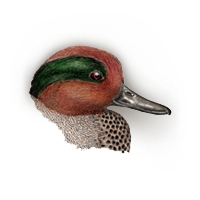|
Field
Guide IDs: BREEDING:
Densely vegetated
inland freshwater lake, marsh, pond, pool, shallow
stream. 1 brood. DISPLAYS:
See:
Duck Displays. NEST:
Well concealed in
clump of tall grass, forbs, brush, or at base of
log or shrub. Occ in vicinity of burn, occ far from
water. Nest of soft grass, forbs, twigs and leaves.
Lined with finer materials and increasing amounts
of down. EGGS:
Cream/light olive
buff. 1.8" (46 mm). DIET:
In summer: aquatic
invertebrates, tadpoles; seeds of emergent and
aquatic veg. In fall: grain, grass, seeds, plant
shoots. Young feed on insects, other invertebrates,
veg gleaned from water's edge, aquatic
veg. CONSERVATION:
Winters s to Baja,
c Mexico and Bahamas. According to Audubon (1840)
individual gunners in w shot 6 dozen/day upon first
arrival of migrants. NOTES:
Young have fastest
growth rate of all N.A. ducks. Male usu abandons
nest before incubation begins. Female covers eggs
when off nest. Uncommon to fairly
common winter visitor at Lagunita, usually seen
foraging in shallows at the edge of the
lake. ESSAYS: Bird
Communities and
Competition;
Metallic
Poisons;
Feathered
Nests;
Dabblers
vs. Divers. REFERENCES:
Bellrose, 1976;
Gooders and Boyer, 1986; Hepp, 1985. |
